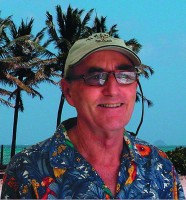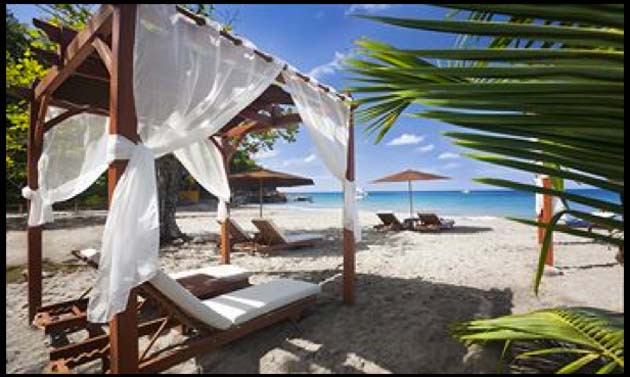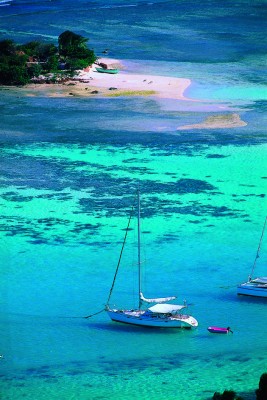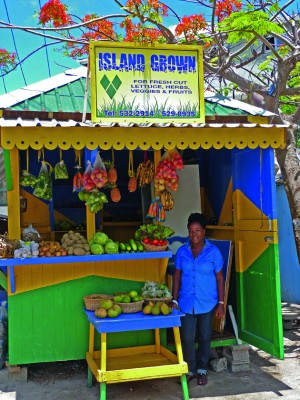You’ve crossed the Atlantic, where do you go now? No one knows the Caribbean like Chris Doyle, so here is his ideal cruising itinerary for those new to the area
Once you’ve put the ocean sailing behind you, where should you cruise during a season in the Caribbean? With some 28 island nations and more than 7,000 islands, the choice is huge. But if you’re smart, you can follow a route that works with the prevailing wind direction and will take you to some of the most interesting places and cultures.
No one knows more about the region than author Chris Doyle, so we gave him carte blanche to describe his ideal cruising itinerary. He suggests starting in Martinique and gently working southwards, as follows:
Grand Anse D’Artlet, Martinique
When I think of Martinique, Grand Anse D’Artlet comes immediately to mind. It is a beautiful and peaceful bay, far from any sizeable town. A tiny village is strung out along a white sand beach, mountains rise behind. The clear pale blue water tempts you to jump in for a snorkel.
These attributes apply to many a Caribbean bay, but Grand Anse D’Artlet is special; something about its towering mountains, the beach and the palms that, in the right light, and especially when the hills are a lush green, divert the mind far from the Caribbean to a distant exotic Pacific hideaway.
It is so lovely, indeed, that many a French cruiser has ended up staying here for years. The town plans to charge for the moorings it laid with EU funds a while ago and this might be a problem for such stalled-out cruisers. Right now, anyone can use the moorings, or not, as they please; there’s no charge.
An excellent government dock makes it easy to get ashore and step into a quiet holiday atmosphere. Some of the beach restaurants have perfect locations, but indifferent service and only passable food. Le P’Ti Bateau, right at the head of the dock, is a restaurant that is pleasant and friendly. If you turn right on the main road, a short walk will bring you to Coco Delices, downhill on the right, where they have a comfortable lounging area for using the wi-fi and they serve good food.
Officialdom is delightfully French. A 20-minute walk takes you to the neighbouring village of Anse D’Arlet, where you can clear in or out on the Customs computer at Cyber Base, the internet store.
Pigeon Island, Rodney Bay, Saint Lucia
Rodney Bay is the yachting capital of Saint Lucia, a thriving, vibrant community surrounding IGY’s pleasantly laid-out Rodney Bay Marina. Restaurants such as The Edge, Jacques, Buzz and Big Chef invite you to try some of the best food the Caribbean has to offer, while many more serve good, but less fancy fare.
You can enjoy what is on offer here, but anchor away from the bustle in the peace and quiet of Pigeon Island, Rodney Bay’s north-west headland. A causeway, covered in hotels, now links Pigeon Island to the shore, but before it was built, Pigeon really was an island and the main base for the British Navy in the days of sailing ships.
Its two hills rise to around 300ft and are linked by a ridge. From up high, you can see Martinique and you have a clear view of any approaching ships. It was a substantial base, with a fort, barracks, storerooms and a hospital.
It is now owned by the Saint Lucia National Trust, which has restored the fort and some buildings. A US$6 entrance fee allows you to wander all over the island, explore the fort, scale the highest hill and wander down the shady paths.
Its name is apt as you will see lots of pigeons of varying types, along with finches, and maybe a tiny sparrowhawk. You are also likely to see a mongoose, whose ancestors were introduced from India. Near the dinghy dock, Barbara’s informal Jambe de Bois, with its easy chairs inside, hobbit chairs outside, wi-fi, and good and inexpensive meals will quickly become your base.
Anse Cochon
For pure sybaritic pleasure a stop in Anse Cochon takes some beating. It is a pleasant bay with excellent snorkelling. If you come ashore mid-afternoon, you may be able to take your dinghy to the dock after the diveboat has left; otherwise, beach it, swells permitting.
Climb the scenic wooden staircase to Ti Kaye hotel at the top of the hill. Here the gardens, the view and the exceptionally friendly staff make you feel as though you have arrived in a little Garden of Eden.
Spend some time and get a massage (or other treatment) at Kai Koko Spa, which is perched on the edge of the cliff and is spectacularly beautiful, with one side of each room open to the precipitous panorama. Take bathing things so you can relax in the welcome room’s hot tub looking right down on the bay.
If you finish in the late afternoon you will be in time to take a relaxing drink in the bar, which is an ideal platform for watching the green flash at sunset. And follow this with a good meal on the restaurant deck, where you can gaze down on your yacht way below, peacefully at anchor.
Blue Lagoon, St Vincent
St Vincent is a spectacular island with some delightful surprises, such as Cumberland Bay, a deep photogenic bay tucked into the rugged and mountainous terrain of the island’s west coast. Five restaurants are dotted around the beach, all apparently making a living off the occasional passing yacht.
Even more surprising is that the government has put in a dock where you can take on water and do laundry, and provide bay-wide free wi-fi right in the middle of nowhere.
While this is good for local hiking, better access to St Vincent’s interior is the area between Blue Lagoon and Young Island Cut, the yachting centre of St Vincent.
Blue Lagoon Marina, St Vincent’s only real marina, has until recently been part of the bareboat industry. Built by CSY, one of the original bareboat companies, it was later taken over by Sunsail. Sometimes so many bareboats were packed in here there was no room.
Recently, Sunsail moved to Grenada, after selling the marina to Kelly and Janke Glace, yachting folk who live nearby. They are transforming it from a make-do charter turn-around facility into a delightful base for visiting St Vincent. There is already a restaurant and beach bar, and soon a new boardwalk café and a quality food shop. Customs has agreed to open a station here too.
This is the perfect place from which to visit two outstanding attractions; Montreal Gardens and the Soufriere volcano. The seven-acre Montreal Gardens are tucked close to the central mountain range at the head of the Mesopotamia Valley, a rich agricultural area about a 20-minute drive from Blue Lagoon.
You will not find more beautiful gardens in the Eastern Caribbean. Tim Vaughn, the owner, has created an intriguing landscape with winding paths, bridges, steps, a tunnel and a river, but his genius is in planting and then letting Nature take over, resulting in a kind of controlled jungle; a riot of colours, leaf shapes and spectacular growth. It is like a visit to some fairytale land where you can, for an hour or two, feel like Alice in Wonderland strolling around in awe of the beauty. The only sounds are rustling leaves, running water and birdsong.
Driving to, and hiking up, the Soufriere volcano takes a whole day. You’ll also expend considerable energy and you will need a guide. However, it is unquestionably one of the Windwards’ most dramatic hikes. Starting on the windward side, you pass through farmland, rainforest, montane forest and then into an area where only tiny plants can survive. The mountain top is often in cloud, cold and damp.
If you take lunch and eat it slowly at the top, you are likely to get a window in the clouds that will allow you to see into the crater, an impressive 1,000ft sheer drop with no guardrail. In the middle, a huge smoking island keeps growing and is now hundreds of feet high, an indication that the volcano’s dormancy is unlikely to last forever.
Union Island
Union is the centre of the southern Grenadines. Want to bring your whole family to visit? Book rooms for them ashore and take them daysailing. From here you are a short hop from the Tobago Cays, where you can frolic with turtles and play on the islands. Palm Island and PSV resorts are close by, as is Mayreau.
All are visible from the best anchorage, which is in brilliant turquoise water tucked up close to the outer reef, not too far from Janti’s Happy Island.
Janti is one of the few people in the world to have built his own island. He created it out of conch shells and concrete on the rubble top of the reef. The result is a very unusual bar, which is very popular at sunset.
For a tiny Grenadine island, the shopping is surprisingly good. It is a real pleasure to visit the local market of colourfully painted wooden stalls surrounding a green, where the vendors will fill your bags with fresh fruit and vegetables. Close by, Nicolas and Linda’s Captain Gourmet is a great little store that sells fresh French bread, yoghurt, frozen shrimp, steak and smoked salmon, along with cheeses and cream. Everyone gathers in the chairs outside the store for coffee or lunch.
Hiking or biking all over the island is well rewarded by spectacular views of the Grenadines. Katie Bingham at Sail Grenadines in the Anchorage Hotel rents bikes. The hike to the Pinnacle is on the tough side, but the view and a sense of accomplishment make it worth the effort.
Hiking Union’s peak
For a tough hike, brimming with challenges and ending with a world-class view, you cannot beat climbing the Pinnacle. It takes about three hours dock to dock. Most of it is an easy regular walk, but the final climb involves non-technical rock scrambling. At the very top you sit on a rock with a heady 360° view.
Long trousers and a long-sleeved shirt, sturdy shoes and a small cutlass (from the local hardware store for about EC$20) will give some protection against prickles.
Take the main road south out of Clifton. It climbs a hill, and at the top take either of the two roads that turn off to the right. Walk up this road and a couple of hundred feet before the antenna compound turn right onto the grass. Head slightly downhill and look for a cut in the trees to take you to another field.
From here, a discernible path leads you down to the water hole (sometimes dry) close to the Pinnacle. When you find the watering hole, head round the left side. A poorly marked path leads through the bush to the base of the Pinnacle. Here the path becomes more apparent. It is very small, tough in places and a real scramble. You can follow the ridge all the way to the highest point, and the views from here make the effort well worth it.
St George’s, Grenada
Grenada, the ‘Isle of Spice’, is a lush and beautiful land full of fruit and spice trees, with sparkling waterfalls and wonderful mountain hikes. Nestled way back in the country is the Grenada Chocolate Factory, a small co-operative that produces some of the best chocolate in the world.
St George’s, the capital, is one of the Caribbean’s most photogenic towns. It flows over a ridge, with the sea on one side and the protected Carenage on the other. Many of the old buildings are built of brick, with roofs of ‘fish scale’ pottery tiles. Fort George stands on the hill to the south, with the hospital underneath.
Across the bay, the Carenage merges into the lagoon, home of Camper and Nicholsons’ lovely Port Louis Marina. The Lagoon is a yachting centre with a big Island Water World chandlery, the Grenada Yacht Club, yacht services, Foodland supermarket and many restaurants.
Grenada’s big international airport and numerous anchorages and marinas on the south coast make it a favourite with cruisers who spend months and sometimes years here, and as soon as you visit you can appreciate why.
Beware the moorings in the Caribbean
Moorings in the Caribbean are often not the haven of security to which you may be accustomed. Many local entrepreneurs put down moorings as personal parking meters and these have no legal status.
They might contain nothing more than a single 45gal drum of concrete held together with worn-away quarter-inch chain – usually with a little good chain and heavy rope near the buoy to fool you. The shackles are rarely wired and can come undone.
On the other hand, most moorings put down by marinas are professionally installed and maintained, and are secure. Marine park and town moorings lie somewhere in the middle. They are at least professionally installed and sometimes well-maintained, but boats have been lost from Caribbean park moorings so take care.
Tobago Cays
The Tobago Cays Marine Park, a short sail from Union Island, is a world-class beauty spot with bountiful underwater wildlife. A group of small uninhabited islands sits inside a big horseshoe reef where you can anchor in shallow water in gorgeous shades of gold, blue, turquoise and green.
Since this area became a park, life has returned to the shallows, making for rewarding snorkelling. Everyone loves to swim with turtles, and green turtles are everywhere, but especially near Baradel Island.
Conchs have come back in a big way and it is lovely to see so many of these shellfish thriving, where once they were rare. Another major beneficiary of the park is the white ‘decorator’ urchin. These were just about extirpated some years ago, they now cluster in huge groups.
Back on the boat, if you are here mid-winter to spring, you can throw some small bread scraps and quickly attract a flock of laughing gulls.
Fishing
As you sail between islands, why not fish for your supper? It is easy and nothing tastes better than fresh fish. Tuna, wahoo, barracuda, kingfish, rainbow runners and Spanish mackerel often go for little plastic lures and they all taste delicious.
You need a gadget that holds the line and releases it when a fish strikes. Clothes pins are not strong enough, but cheap plastic awning clamps work well, as do plastic woodworking spring clamps. I tie my line way up high, then clamp it at deck level, so when a fish strikes, the line jumps out of the clamp and I see it pulling.
When you catch a fish, slow the boat by luffing or rolling up the jib. I keep a big ice chest handy, which saves a lot of mess on deck. You will be able to haul up most fish by hand; gloves will protect your fingers from line cuts.
Nearly anything you catch between Martinique and Grenada will be edible, but I throw back Spanish mackerel, barracuda and jacks if they weigh more than 2kg.
This is an extract from a feature in the November 2014 issue of Yachting World

















